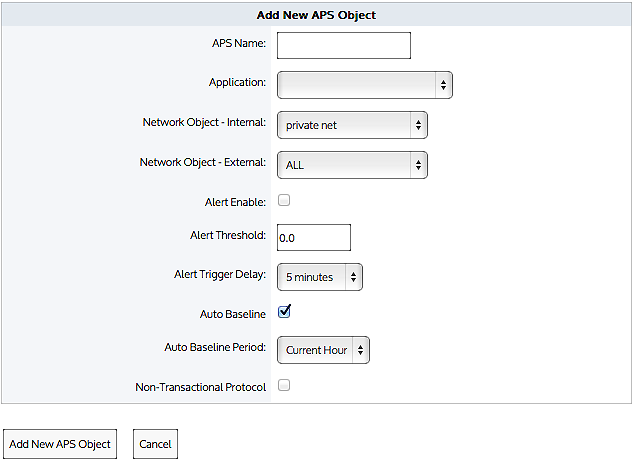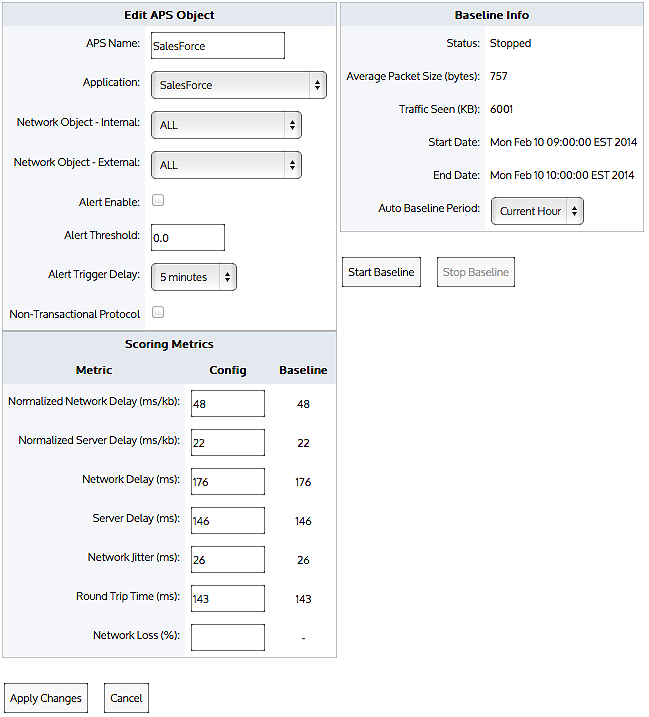Configuring application performance score objects
The application performance score (APSApplication Perfromance Score) object is used to assess how network users enjoy the network performance experience of business-critical applications. The score, ranging between 0 and 10, where 0 is poor and 10 is excellent, indicates whether the app is performing as well as expected or is performing poorly. By creating an APS object, you specify an application to monitor. Optionally, you can also specify a network objecta logical definition created and stored in the Exinda lilbrary, can represent any network component so that the application is only monitored when observed on that part of the network. You set thresholds on one or more network metrics. Later, traffic for that application is assessed against those thresholds to determine how well the application is performing.
The appropriate thresholds for an application is unique for each network environment. You can manually set the thresholds for the network metrics or you can have the system automatically create threshold values by having the system observe traffic to determine reasonable baselineused by monitors and performance reports to establish a standard by which sunsequent performance can be measured values. The metrics include network delay, server delay, round trip time, jitter, and network loss. Note that you can manually set the network loss metric, however, it will not be automatically be calculated during the baseline analysis. You can use one or more of these metrics in your APS object. Most applications use transactional protocols. Applications like Citrix XenApp server or Microsoft Remote Desktop use non-transactional protocols that send information between the client and server at arbitrary times. With these types of applications, the standard method of calculating the network delays and server delays does not produce an accurate metric. If the application uses a non-transactional protocol, you must specify that when creating APS object.
For the baselining analysis, traffic is analyzed during the specified period, and a set of metric thresholds is generated. The threshold recommendations target an APS of 8.5. If the application reports an APS below 8.5, the application is performing worse than the baseline. If no traffic is observed during the baselining period, then the appliance will automatically start another the baseline analysis for the next larger time period. Email will be sent for each unsuccessful baseline analysis.
NOTE
It is a best practice to start the baseline analysis during a time period when you would expect traffic for the application is typical. This will ensure that the baseline values accurately reflect the typical usage of the application.
This means that if network conditions changes, it is recommended that the thresholds are re-evaluated.
NOTE
APS is not supported for small-packet applications like Citrix and RDP. The metrics are normalized as if the application runs with larger packet sizes, leading to larger values.
You can also set alerts so that you will be notified when the score drops below a certain threshold value. There is an alert trigger delay setting which requires that the score remains below the alert threshold for a specified period of time before triggering the alert. This prevents brief temporary poor scores from appearing like an emergency.

The form to add a new APS object.
When editing the APS object, you can modify the alert configuration, restart the baselining operation, and modify the threshold values. If you change the network object settings, it is recommended that you re-evaluate the metric thresholds and possibly re-start a baseline.

Editing an APS object.